Agriculture for the next generation and feeling pride in farming: Thoughts on the new YT series tractor.
Beginning with Kiyoyuki Okuyama’s striking concept tractor which embodies YANMAR’s challenge of facing the future of agriculture, through a century of accumulated technology in not only agriculture itself, but the service and support structure that surrounds it, there are many different stories to be told of the mass-production of the YT tractor. Today we bring you a few of those stories.
To bring you this last part of the Inside Story of the mass production of the YT Series, we introduce the project team that went beyond department and business unit boundaries. From the start, this was a cross departmental project that overcame a high level of difficulty to realize an innovative design and comfort that considered the user’s perspective.
We gathered the following members of the interdepartmental project to talk about the formative episodes in this exciting project. Project Manager Shigemi Hidaka from the Project Management Division of the Agricultural Operations Business, Ibe Toshihiko and Fumio Ishibashi from the Product Development Division of the Agricultural Operations Business, Mia Mori from the Administration Division of the Agricultural Operations Business, Akira Takahashi from the Quality Assurance Division of the Agricultural Operations Business , Akihiro Kousa and Naoyuki Wakizaka from Production Planning Division, Yanmar Agricultural Machinery Manufacturing Co., Ltd., and Yu Yamasaki from the Marketing Promotion Group of the Promotion Division of Yanmar Agri Japan.

Marketing from Planning and Concept; towards exceeding customer expectations …… An inter-departmental project that realizes information sharing and speedy decision making.
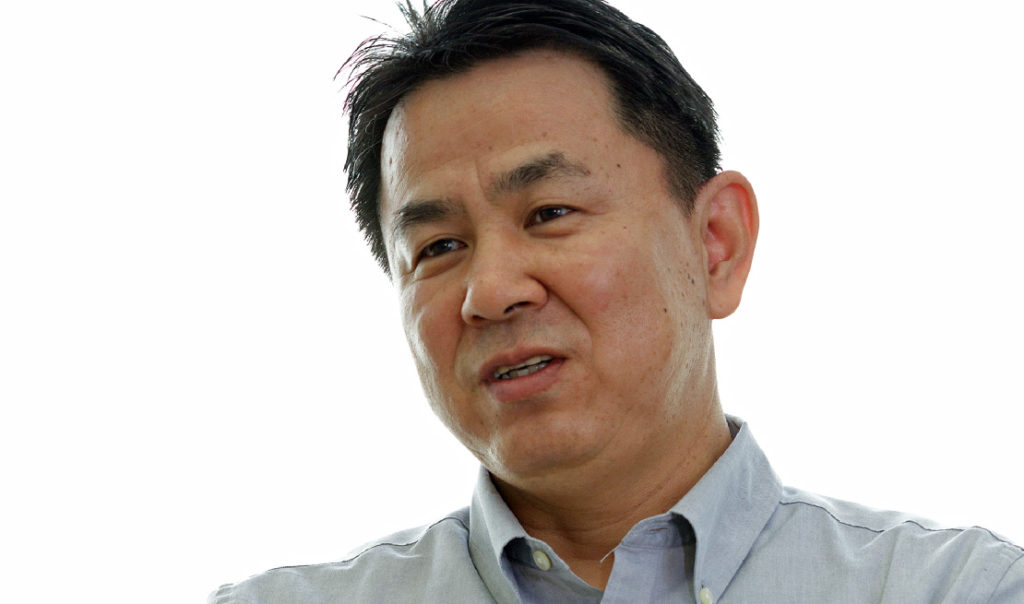
–Can you tell us first about how the project was positioned? What can you tell us about how it was launched?
Shigemi Hidaka This project encompassed tractor planning, concept, development, production, quality assurance, and service up to marketing and then on to delivering the best experience to the end user. So from the start this was not to be a “siloed” development process where each department struggles to get in contact with the other but rather, the process went forward with all departments linked and working together. We commenced the project from the perspective of general tractor development, but this coincided with the Premium Brand Project and overlapped with the YT series planning and development period.
One of the issues we were aware of was that with agricultural equipment development, there are a lot of areas where the development process from planning to sales is rather compartmentalized, and with few horizontal connections, the flow of information to other departments is limited. We tried to gather key human resources that would carry the company into the next generation and speed and smooth communication as much as possible.
Fumio Ishibashi Not just with this project but for the Agricultural Operations Business in general, we’ve been working to improve the product commercialization process to realize greater profitability through efficiency. In order to avoid rework, we concentrated on the early part of development in a system called “7:3 development”. Naturally, at this stage there was a need to form multi-department working groups. On this basis, we attempted to ascertain what departments needed what information and prepare it before meetings, and worked together on overlapping areas.
–Both a company-wide problem-solving approach and the project to reshape the future of agriculture were moving along at this time. Against this background, how did you manage the progress of YT project?
Mai Mori We had one to two meetings a month. In the beginning we often got together this way, but then when things began moving, the number of meetings also increased, and recently we’ve been having more and more video conferences.
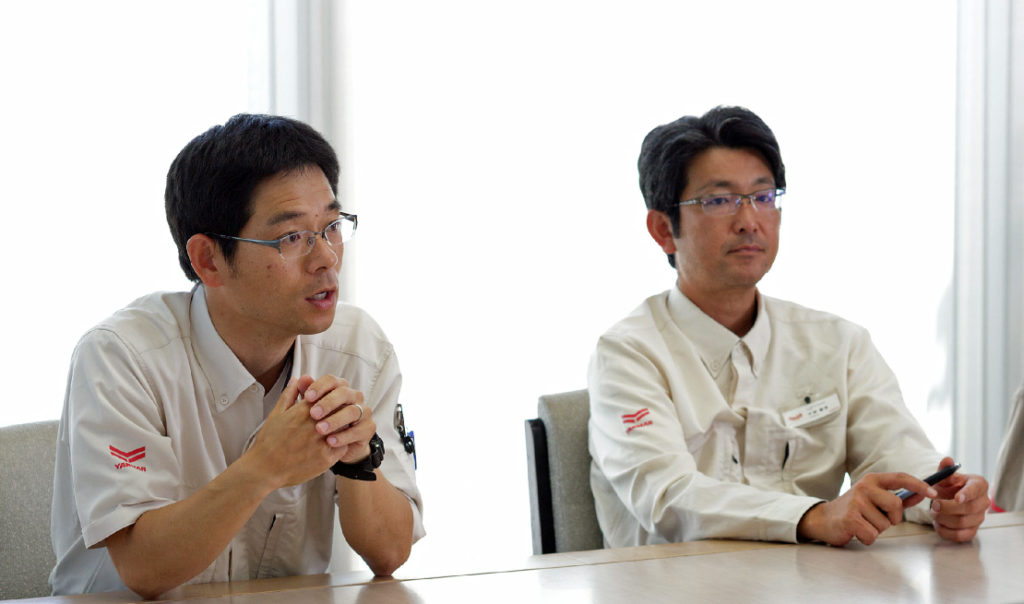
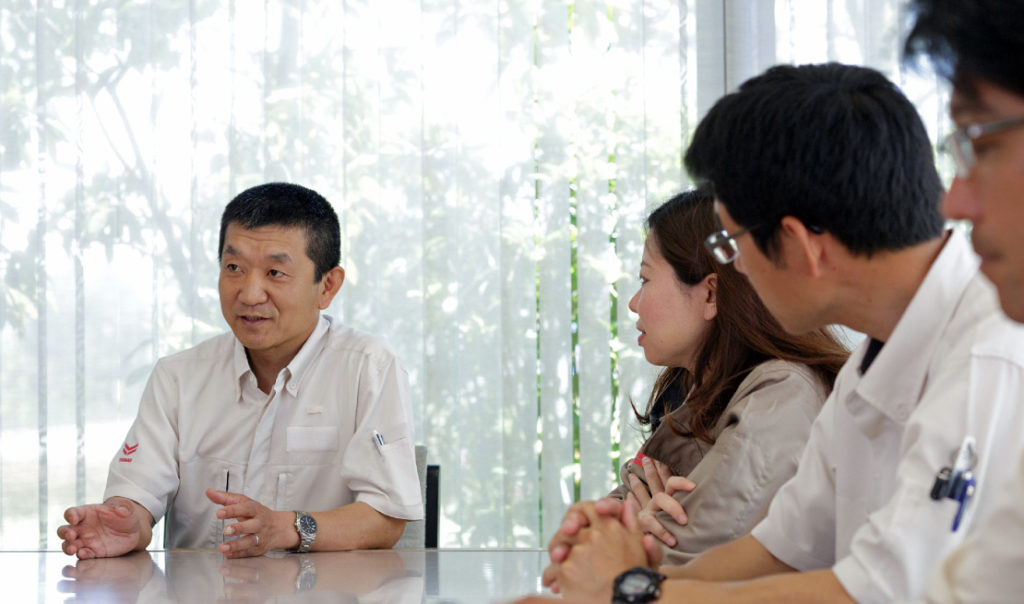
–So, you’re all here as representatives of your respective departments.
Akira Takahashi Yes, that’s right. I’m from the Quality Assurance Division. Where ever possible, I look at the situation and make a call, but there are also many situations where I take a problem back to the department and get the opinion of an expert. With “7:3 Development” this project is somewhat different to others in that usually the safety checks are left till after the machine is finished, but a lot of checks were able to be carried out at the 3D-CAD stage.
Yu Yamasaki At the start of development, we gathered together frontline sales staff to give them our ideas behind development and also to try and pick up areas of possible improvement, or deficiencies. As with Quality Assurance, usually it’s a case of “Sell this machinery we made”, but this time round, at the 3D stage we were able to take the armrest which has a key role in operability and have the sales staff check it and get their feedback. Similarly, we were able to check each and every component part. Not only were we concerned with the image of the product, but we were able to reassure ourselves that the level of fundamental performance had improved.

–Mr. Yamazaki, even though you’re responsible for sales promotion you can discuss the development process in such detail. Was it such a major factor to be able to see the development process from an early stage?
Yu Yamasaki Up to now, really the only opportunity for the factory members involved in commercialization of the product to get together was at the Commercialization Review Meeting and even then we really only exchanged pleasantries. The factory and development teams wouldn’t even know who the marketing members were. This time, a big difference is that we see each other on a daily basis and face the challenges together.
Mai Mori Yes, I think you’re onto something there. Up to now, the manufacturing side and sales side never had much to do with each other, but this way, we can really understand what kind of problems the other has and talk through them.
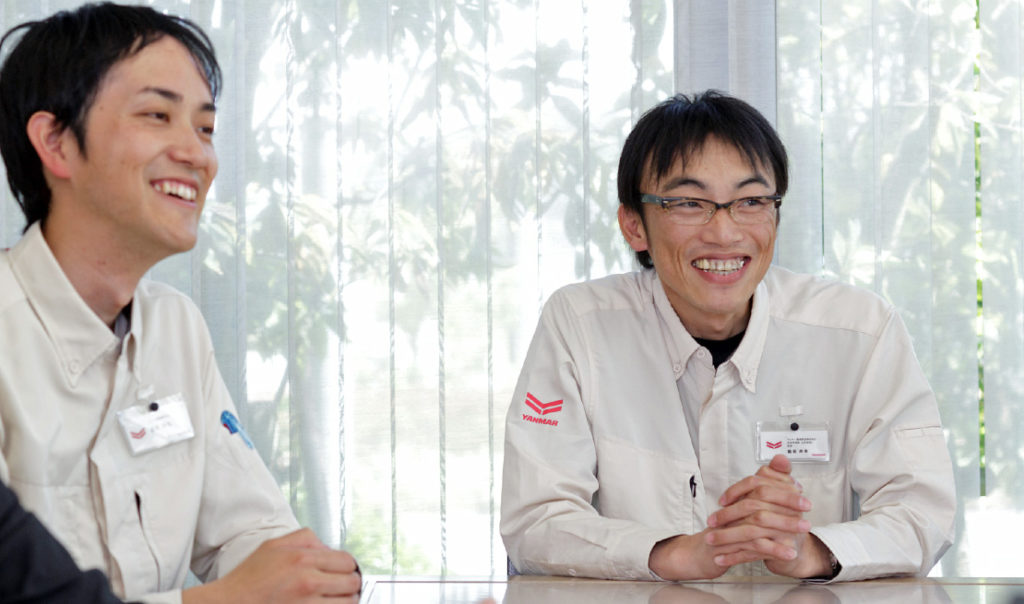
–Mr. Wakizaka and Mr. Takasa, you’re usually in the factory. How did you find this situation?
Akihiro Kousa From the time when we started doing development with 3D plans, we’re thinking about factory machinery and the setup of the production lines. Rather than seeing the test vehicle as the start of production, I always consider the first machinery that rolls off the mass production line to be the defining moment. Personally, I’ve been involved with this project for a long time now – you could say it has become my life’s work. I could talk about the atmosphere of the project and share things that need to be discussed, but there are some things that only someone steeped in the culture of the factory would understand.
–Was there a knack to getting your message across?
Naoyuki Wakizaka Passion (laughing). If each department didn’t do the things they were supposed to according to their responsibilities on the schedule, as Project Manager Hidaka says, you’re just causing a problem for the next person. Where there’s something that has to be done, Passion… was able to get across the feeling that more needed to be done.
Toshihiko Ibe Basically, when I’m working on development, I’m only thinking about the machinery that I’m working on. That’s the way I’ve done things up to now. When this project was established with its many venues for information sharing, I felt as though the development team was really being driven forward. If something came up in the meeting and you could do something about it, then you did. And that goes for both the factory and marketing. Another thing is the speed. As far as quality was concerned, development has its own concerns, as does quality assurance, but when you get them in the same room looking over the same plans, the checking process is greatly speeded up with things decided on the spot. It felt like getting in each other’s way, somehow sped up development and increased quality.
Yu Yamasaki Speaking of “speed”, we also liaised with the implement manufacturers at an early stage. After all, a tractor is a piece of equipment that works hand in glove with its implements and attachments. At an early stage in development, we actually took the test machine out to the implement makers and conducted a work test, and worked with the implement manufacturers on the design to get a sense of the tractor and implement as a complete unit, when coupled with the genuine front loader. By conducting test activities directly with the implement makers, I feel like we were able to speed things up. I think this would be an important point to take forward on other projects.

–Ms. Mori, you were responsible for costs, weren’t you.
Mai Mori There were a lot of things we did differently, when it came to costs. The pointed shape of the bonnet meant that construction techniques were completely different to previous tractors. We had no idea how much it was going to cost to build it this way.
Fumio Ishibashi Frontline sales staff were listening to the customers and coming back to development saying: “We want this feature”, “add this, add that…” and costs began to spiral. Eventually, Ms. Mori just said: “Come on, do we really need that feature?”
Mai Mori Well, I don’t think that was what I actually said. (laughing)
Yu Yamasaki We debated about what to do with the seat, whether various features were needed or not, and whether to make them standard or optional. In order to set the tractor at a price point that users could accept, we looked closely at each element and discussed each thoroughly.
Mai Mori When it came to money and purchasing, matters that were discussed and decided within the team needed to be shared with the Procurement Dept. and various external partners. In these situations, development members and the Product Manager also participated. It was a product with many parties involved and it was difficult to manage costs. If we’d proceeded as we have up to now, there’s no way we could have done it.
A model of YANMAR’s new manufacturing approach for the next 100 years.
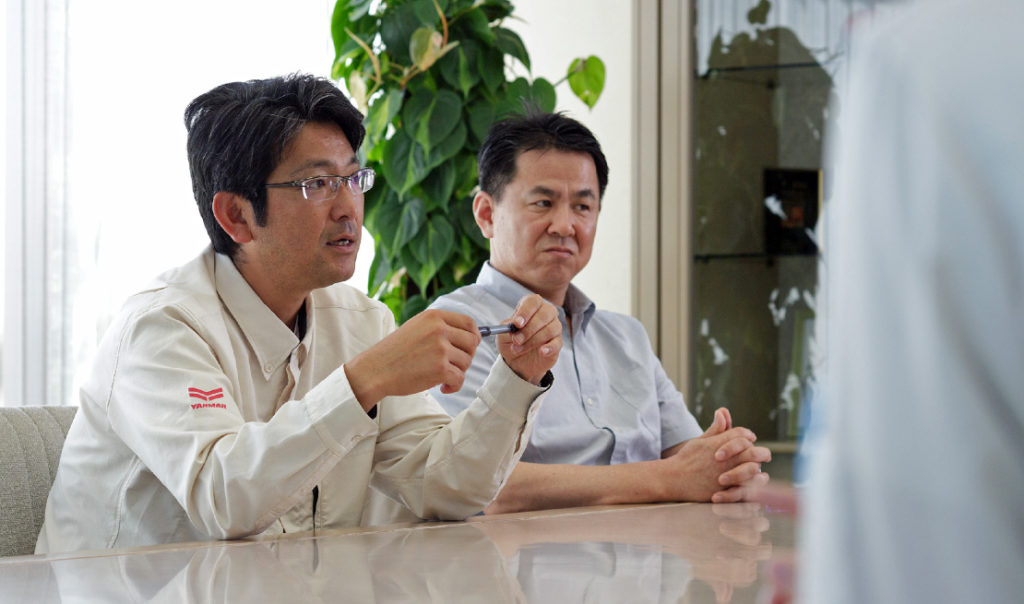
–The YT Series is now in mass production with sales underway. With the Planning Dept. having been involved over such a long period, how is communication proceeding with other departments?
Shigemi Hidaka I think this also differs from the usual approach of information gradually seeping out to nearby members. Rather, matters that were decided in the project meetings were proactively shared with the respective departments. Now we’re at the point where the machinery is hitting the market so we’re getting inquiries from the various departments asking how things went.
Yu Yamasaki In fact, it’s already in customers’ hands. From here on, we’ll be trying to respond speedily to whatever comes our way, whether it’s good news or bad. The way we handle this response is changing I think.
Shigemi Hidaka Continuous trial and error. There’s been a lot said up to now, with the factory and sales each in contact with their respective bases and being pulled different ways. Development might decide they can bring the delivery date forward a little. But then where does that leave everyone else? You get quite a frank exchange of opinions. I think in the end, everyone will be appreciative of each other’s efforts, but we’re not there yet.
–It seems that you’re very supportive of each other.
Toshihiko Ibe Even if there’s no news from me, Wakizaka will say: “I haven’t heard from you but this is the way things are going, right?” That way, he’s moving ahead and getting in front of things. “Go for it Wakizaka!” I say. I’m the kind who relies on others (laughs).
Naoyuki Wakizaka Me too (laughs)
Shigemi Hidaka Even though it’s a project, it does rely a lot on individual effort. I think this really translates to a strong commitment to the product.
–Feelings of attachment… Those who’ve been involved with the YT Series over a long period tend to develop strong feelings towards it, don’t they. With the mass production in progress, what is there that you look back on?
Yu Yamasaki The sales staff at the frontlines often say: “You’ve done well to bring this to life!” The release of the concept model really raised a lot of expectations but then they tell us “What a great job you’ve done with development.” One of the sales outlets put it this way: “Now it’s our turn to bring this product to the customers.” That really made me happy. We’ve even started to get a bit of feedback from tractor customers: “It’s not just cool.” They really appreciate the performance, function and operability. I want more and more people to try it and experience it for themselves.
Fumio Ishibashi I’ve been involved with the project when there was nothing, just an idea. It’s come together bit by bit; what kind of form, what kind of configuration, cost, delivery period… through all of the little details. We even had to go pick up parts directly from the manufacturer once so that we could meet a production deadline, but meet it we did. My notebook contained 3D data for parts and in meetings I would show the part and talk about it in the meeting “Now this part…” Looking at the finished product, you can’t see the part anymore. No one looked at that part more than I did.
Toshihiko Ibe I poured my soul into each and every part.
Yu Yamasaki It makes me happy to be involved in the flagship model that leads YANMAR into its next 100 years. I felt strongly my responsibility to properly represent the many staff back at my department.
Naoyuki Wakizaka When we shipped off the test vehicle I really felt something inside. (laughs)
Toshihiko Ibe I got goosebumps when they first started up the test vehicle.
Mai Mori I’m not actually involved in the manufacturing so I feel a little envious (laughs). But when we held the completion ceremony for the test vehicle, Hidaka-san made a speech where he thanked not only the members here, but he read out all the names of Procurement and all the other departments involved. The efforts of so many people came together to make this one machine, it’s quite moving. From the start of the project, at first of course some things didn’t go as well as expected, but a feeling emerged that we were all working together to realize this, and it gradually got easier to get everyone’s cooperation.
–I think this shows the way to a new direction for YANMAR’s manufacturing technology.
Shigemi Hidaka Its shows what we’re capable of. There were challenges, but it was great that the members really pulled together. Each and every one of us realized what we had to do and pulled out all the stops. That passion was what made everything possible. I think for the next tractor development, we’ll have to create a system where we achieve improvements through meetings and create an atmosphere where everyone in the company has an awareness of what we’re working towards.
All of the project members gathered for the interviews talked about “Trial and Error”. From Kiyoyuki Okuyama, the Maibara R&D Center engineers, through to everyone in the support staff, everyone talked about the mass production of the YT Series as the beginning of YANMAR’s next century.
From the YT Series, the story of YANMAR’s tractor development is still in the making. In the future, we hope to bring you more stories like this of the thinking behind development and through the words of those on the ground, share more of YANMAR’s philosophy.
Profiles
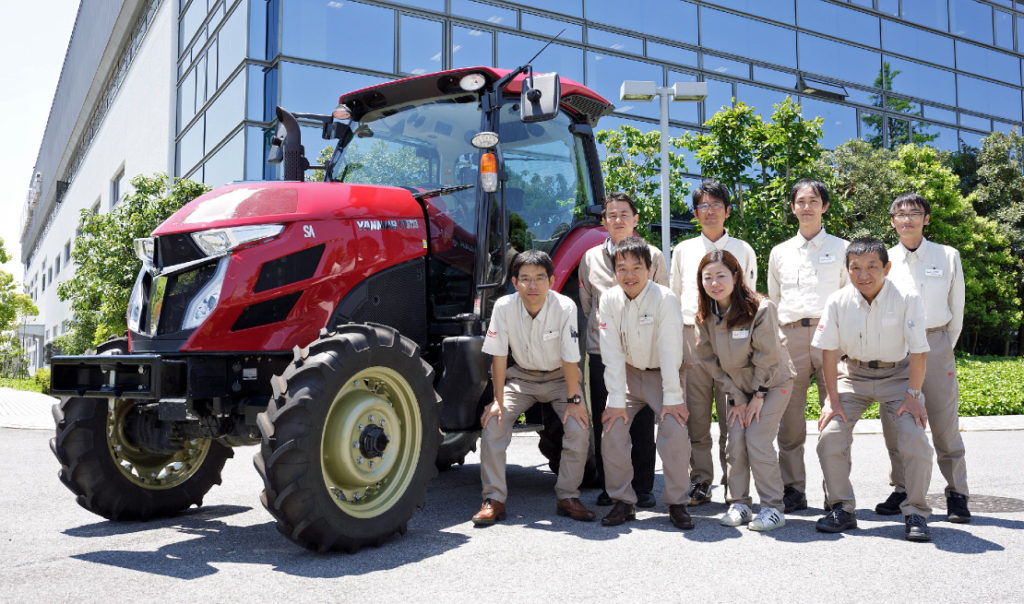
(From the rear row)
Project Manager (Tractor), Project Management Division, Agricultural Operations Business, Yanmar Co., Ltd.
Shigemi Hidaka
Senior Engineer, Product Development Division 1, Development Division, Agricultural Operations Business, Yanmar Co., Ltd.
Toshihiko Ibe
(at Ibuki factory) Production Engineering Division, Production Planning Division, Yanmar Agricultural Machinery Manufacturing Co., Ltd.
Akihiro Kousa
Project Manager, Production Administration Group, Production Administration Division, Production Planning Division, Yanmar Agricultural Machinery Manufacturing Co., Ltd.
Naoyuki Wakizaka
Senior Engineer, Product Development Division 1, Development Division, Agricultural Operations Business, Yanmar Co., Ltd.
Fumio Ishibashi
Marketing Promotion Group, Agricultural Promotion Division, Yanmar Agri Japan Co., Ltd.
Yu Yamasaki
Cost Planning Group, Administration Division, Agricultural Operations Business, Yanmar Co., Ltd.
Mai Mori
Project Manager (at Okuyama) Quality Assurance Division, Agricultural Operations Business, Yanmar Co., Ltd.
Akira Takahashi

























